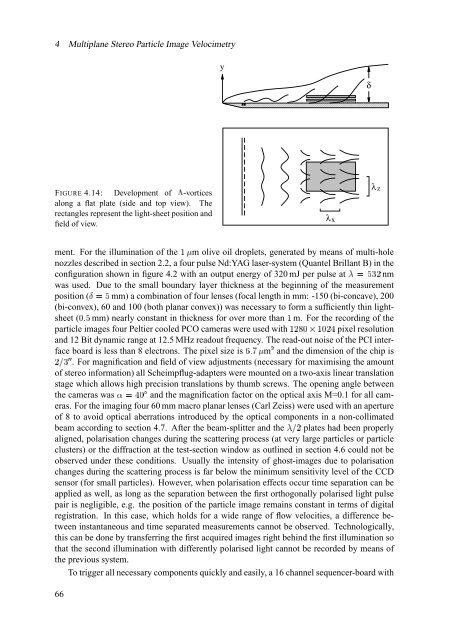The significance of coherent flow structures for the turbulent mixing ...
The significance of coherent flow structures for the turbulent mixing ...
The significance of coherent flow structures for the turbulent mixing ...
Create successful ePaper yourself
Turn your PDF publications into a flip-book with our unique Google optimized e-Paper software.
4 Multiplane Stereo Particle Image Velocimetry<br />
y<br />
δ<br />
ÔÓÔÓÔÓÔÓÔÓÔÓÔÓÔÓÔÓÔÓÔÓÔÓÔÓÔÓÔÓÔÓÔÓÔÓÔÓÔÓÔÓÔ<br />
ÒÓÒÓÒÓÒÓÒÓÒÓÒÓÒÓÒÓÒÓÒÓÒÓÒÓÒÓÒÓÒÓÒÓÒÓÒÓÒÓÒÓÒÓÒ<br />
FIGURE 4.14: Development Ñ <strong>of</strong> -vortices<br />
along a flat plate (side and top view). <strong>The</strong><br />
rectangles represent <strong>the</strong> light-sheet position and<br />
field <strong>of</strong> view.<br />
λx<br />
λ z<br />
ment. For <strong>the</strong> illumination <strong>of</strong> <strong>the</strong> ÆÖÕ m olive oil droplets, generated by means <strong>of</strong> multi-hole<br />
nozzles described in section 2.2, a four pulse Nd:YAG laser-system (Quantel Brillant B) in <strong>the</strong><br />
configuration shown in figure 4.2 with an output energy <strong>of</strong> 320 mJ per pulse at ×ÙØÚÈ¿Â0Û nm<br />
was used. Due to <strong>the</strong> small boundary layer thickness at <strong>the</strong> beginning <strong>of</strong> <strong>the</strong> measurement<br />
position (ÜÝØVÈ mm) a combination <strong>of</strong> four lenses (focal length in mm: -150 (bi-concave), 200<br />
(bi-convex), 60 and 100 (both planar convex)) was necessary to <strong>for</strong>m a sufficiently thin lightsheet<br />
(¾ÁÌÈ mm) nearly constant in thickness <strong>for</strong> over more than Æ m. For <strong>the</strong> recording <strong>of</strong> <strong>the</strong><br />
particle images four Peltier cooled PCO cameras were used with ÆÛ¿Þ¾ÝÄFƾ0Û[Ë pixel resolution<br />
and 12 Bit dynamic range at 12.5 MHz readout frequency. <strong>The</strong> read-out noise <strong>of</strong> <strong>the</strong> PCI interface<br />
board is less than 8 electrons. <strong>The</strong> pixel size is ßÁÉÎ@Õ mÊ and <strong>the</strong> dimension <strong>of</strong> <strong>the</strong> chip is<br />
Ûà¿Â?á á . For magnification and field <strong>of</strong> view adjustments (necessary <strong>for</strong> maximising <strong>the</strong> amount<br />
<strong>of</strong> stereo in<strong>for</strong>mation) all Scheimpflug-adapters were mounted on a two-axis linear translation<br />
stage which allows high precision translations by thumb screws. <strong>The</strong> opening angle between<br />
<strong>the</strong> cameras was âãØäË0¾ À and <strong>the</strong> magnification factor on <strong>the</strong> optical axis M=0.1 <strong>for</strong> all cameras.<br />
For <strong>the</strong> imaging four 60 mm macro planar lenses (Carl Zeiss) were used with an aperture<br />
<strong>of</strong> 8 to avoid optical aberrations introduced by <strong>the</strong> optical components in a non-collimated<br />
beam according to section 4.7. After <strong>the</strong> beam-splitter and <strong>the</strong> ×màÛ plates had been properly<br />
aligned, polarisation changes during <strong>the</strong> scattering process (at very large particles or particle<br />
clusters) or <strong>the</strong> diffraction at <strong>the</strong> test-section window as outlined in section 4.6 could not be<br />
observed under <strong>the</strong>se conditions. Usually <strong>the</strong> intensity <strong>of</strong> ghost-images due to polarisation<br />
changes during <strong>the</strong> scattering process is far below <strong>the</strong> minimum sensitivity level <strong>of</strong> <strong>the</strong> CCD<br />
sensor (<strong>for</strong> small particles). However, when polarisation effects occur time separation can be<br />
applied as well, as long as <strong>the</strong> separation between <strong>the</strong> first orthogonally polarised light pulse<br />
pair is negligible, e.g. <strong>the</strong> position <strong>of</strong> <strong>the</strong> particle image remains constant in terms <strong>of</strong> digital<br />
registration. In this case, which holds <strong>for</strong> a wide range <strong>of</strong> <strong>flow</strong> velocities, a difference between<br />
instantaneous and time separated measurements cannot be observed. Technologically,<br />
this can be done by transferring <strong>the</strong> first acquired images right behind <strong>the</strong> first illumination so<br />
that <strong>the</strong> second illumination with differently polarised light cannot be recorded by means <strong>of</strong><br />
<strong>the</strong> previous system.<br />
To trigger all necessary components quickly and easily, a 16 channel sequencer-board with<br />
66
















